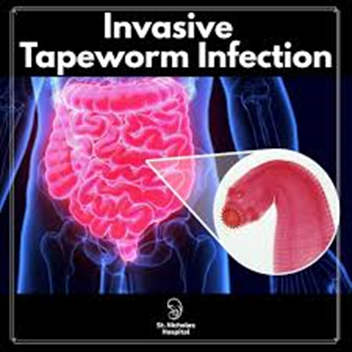Tapeworm
Infection
Overview
Tapeworm infection is caused
by ingesting food or water contaminated with tapeworm eggs or larvae. If you
ingest certain tapeworm eggs, they can migrate outside your intestines and form
larval cysts in body tissues and organs (invasive infection). If you ingest
tapeworm larvae, however, they develop into adult tapeworms in your intestines
(intestinal infection).
An adult tapeworm consists
of a head, neck and chain of segments called proglottids. When you have an
intestinal tapeworm infection, the tapeworm head adheres to the intestinal
wall, and the proglottids grow and produce eggs. Adult tapeworms can live for
up to 30 years in a host.
Intestinal tapeworm
infections are usually mild, with only one or two adult tapeworms. But invasive
larval infections can cause serious complications
Symptoms
Many people with intestinal
tapeworm infection don't have symptoms. If you do have problems from the
infection, your symptoms will depend on the type of tapeworm you have and its
location. Invasive tapeworm infection symptoms vary depending on where the
larvae have migrated.
Intestinal infection
Signs and symptoms of
intestinal infection include:
Nausea
Weakness
Loss of appetite
Abdominal pain
Diarrhea
Dizziness
Salt craving
Weight loss and inadequate
absorption of nutrients from food
Invasive infection
If tapeworm larvae have
migrated out of your intestines and formed cysts in other tissues, they can
eventually cause organ and tissue damage, resulting in:
Headaches
Cystic masses or lumps
Allergic reactions to the
larvae
Neurological signs and
symptoms, including seizures
When to see a doctor
If you experience any of the
signs or symptoms of tapeworm infection, seek medical attention.
Ingestion of eggs. If you
eat food or drink water contaminated with feces from a person or animal with
tapeworm, you ingest microscopic tapeworm eggs. For example, a dog infected
with a tapeworm will pass tapeworm eggs in its feces, which get into the soil.
If this same soil comes in
contact with a food or water source, it becomes contaminated. You can then be
infected when you eat or drink something from the contaminated source.
Once inside your intestines,
the eggs develop into larvae. At this stage, the larvae become mobile. If they
migrate out of your intestines, they form a cyst in the liver or other tissues.
Ingestion of larvae cysts in
meat or muscle tissue. When an animal has a tapeworm infection, it has tapeworm
larvae in its muscle tissue. If you eat raw or undercooked meat from an
infected animal, you ingest the larvae, which then develop into adult tapeworms
in your intestines.
Adult tapeworms can measure
more than 80 feet (25 meters) long and can survive as long as 30 years in a
host. Some tapeworms attach themselves to the walls of the intestines, where
they cause irritation or mild inflammation, while others may pass through to
your stool and exit your body.
Risk factors
Factors that may put you at
greater risk of tapeworm infection include:
Poor hygiene.
Infrequent washing and bathing increases the risk of accidental transfer of
contaminated matter to your mouth.
Exposure to livestock.
This is especially problematic in areas where human and animal feces are not
disposed of properly.
Traveling to developing
countries. Infection occurs more frequently in areas
with poor sanitation practices.
Eating raw or
undercooked meats. Improper cooking may fail to kill
tapeworm eggs and larvae contained in contaminated pork or beef.
Living in endemic
areas. In certain parts of the world, exposure to
tapeworm eggs is more likely. For instance, your risk of coming into contact
with eggs of the pork tapeworm (Taenia solium) is greater in areas of Latin
America, China, sub-Saharan Africa or Southeast Asia where free-range pigs may
be more common.
Complications
Intestinal tapeworm
infections usually don't cause complications. If complications do occur, they
may include:
Digestive blockage. If
tapeworms grow large enough, they can block your appendix, leading to infection
(appendicitis); your bile ducts, which carry bile from your liver and
gallbladder to your intestine; or your pancreatic duct, which carries digestive
fluids from your pancreas to your intestine.
Brain and central
nervous system impairment. Called neurocysticercosis
(noor-o-sis-tih-sur-KOE-sis), this especially dangerous complication of
invasive pork tapeworm infection can result in headaches and visual impairment,
as well as seizures, meningitis, hydrocephalus or dementia. Death can occur in
severe cases of infection.
Organ function
disruption. When larvae migrate to the liver, lungs or
other organs, they become cysts. Over time, these cysts grow, sometimes large
enough to crowd the functioning parts of the organ or reduce its blood supply.
Tapeworm cysts sometimes rupture, releasing more larvae, which can move to
other organs and form additional cysts.
A ruptured or leaking cyst
can cause an allergy-like reaction, with itching, hives, swelling and
difficulty breathing. Surgery or organ transplantation may be needed in severe
cases.
Prevention
To prevent tapeworm
infection:
Wash your hands with soap
and water before eating or handling food and after using the toilet.
When traveling in areas
where tapeworm is more common, wash and cook all fruits and vegetables with
safe water before eating. If water might not be safe, be sure to boil it for at
least a minute and then let it cool off before using it.
Eliminate livestock exposure
to tapeworm eggs by properly disposing of animal and human feces.
Thoroughly cook meat at
temperatures of at least 145 F (63 C) to kill tapeworm eggs or larvae.
Freeze meat for as long as
seven to 10 days and fish for at least 24 hours in a freezer with a temperature
of -31 F (-35 C) to kill tapeworm eggs and larvae.
y treat dogs infected with
tapeworm
Avoid eating raw or
undercooked pork, beef and fish.
Jan Ricks Jennings, MHA, LFACHE
JanJenningsBlog.Blogspot.com
412.913.0636 Cell
724.733.0509 Office




No comments:
Post a Comment